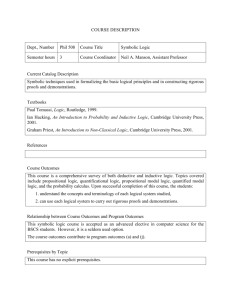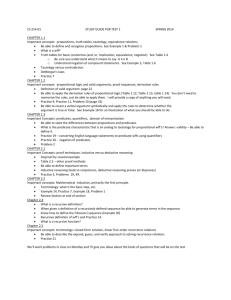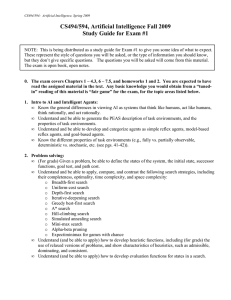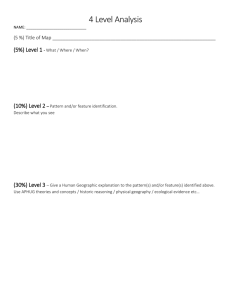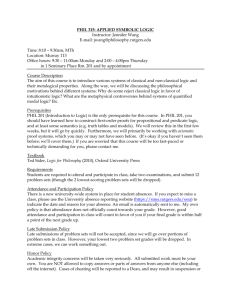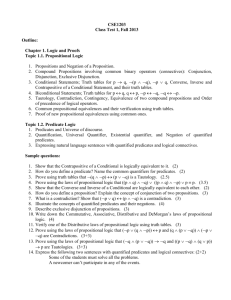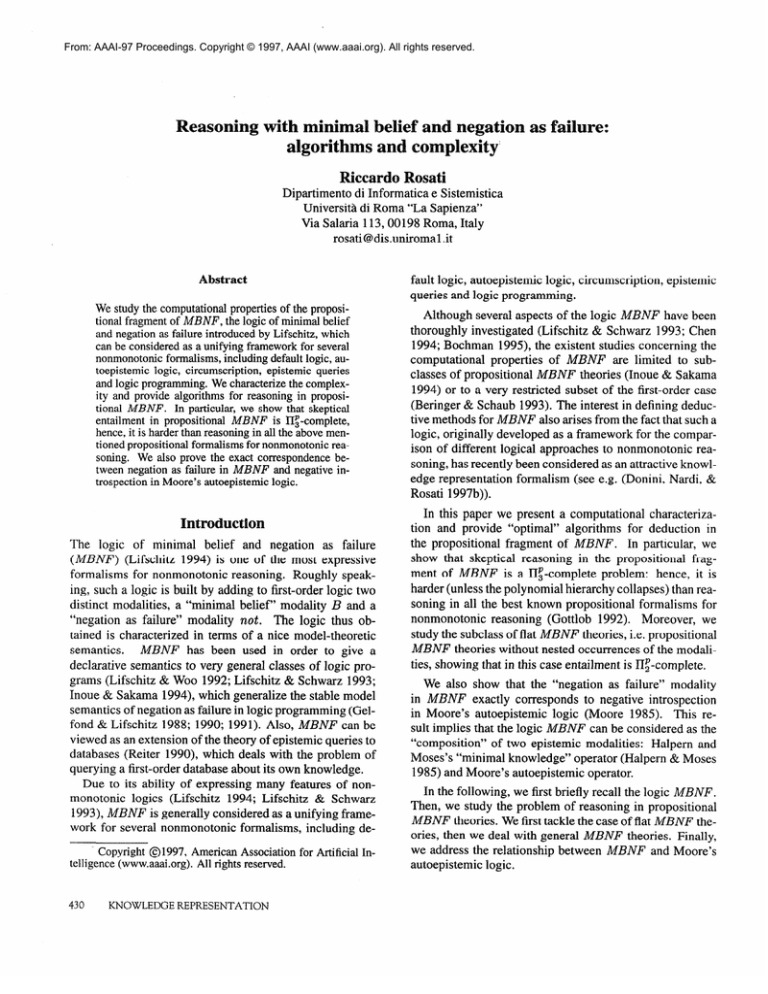
From: AAAI-97 Proceedings. Copyright © 1997, AAAI (www.aaai.org). All rights reserved.
Reasoning with minimal
negation as
Dipartimento di Informatica e Sistemistica
Universita di Roma “La Sapienza”
Via Salaria 113,OO 198 Roma, Italy
rosati@dis.uniromal
.it
Abstract
We study the computational properties of the propositional fragment of MBNF, the logic of minimal belief
and negation as failure introduced by Lifschitz, which
can be considered as a unifying framework for several
nonmonotonic formalisms, including default logic, autoepistemic logic, circumscription, epistemic queries
and logic programming. We characterize the complexity and provide algorithms for reasoning in propositional MBNF. In particular, we show that skeptical
entailment in propositional MBNF is II;-complete,
hence, it is harder than reasoning in all the above mentioned propositional formalisms for nonmonotonic reasoning. We also prove the exact correspondence between negation as failure in MBNF and negative introspection in Moore’s autoepistemic logic.
Introduction
The logic of minimal belief and negation as failure
(A03NF) (Lifschitz 1994) is one of the most expressive
formalisms for nonmonotonic reasoning. Roughly speaking, such a logic is built by adding to first-order logic two
distinct modalities, a “minimal belief” modality B and a
“negation as failure” modality not. The logic thus obtained is characterized in terms of a nice model-theoretic
MBNF has been used in order to give a
semantics.
declarative semantics to very general classes of logic programs (Lifschitz & Woo 1992; Lifschitz & Schwarz 1993;
Inoue & Sakama 1994), which generalize the stable model
semantics of negation as failure in logic programming (Gelfond & Lifschitz 1988; 1990; 1991). Also, MBNF can be
viewed as an extension of the theory of epistemic queries to
databases (Reiter 1990), which deals with the problem of
querying a first-order database about its own knowledge.
Due to its ability of expressing many features of nonmonotonic logics (Lifschitz 1994; Lifschitz & Schwarz
1993), MBNF is generally considered as a unifying framework for several nonmonotonic
formalisms, including deCopyright 01997,
telligence (www.aaai.org).
430
American Association for Artificial InAll rights reserved.
KNOWLEDGE REPRESENTATION
fault logic, autoepistemic logic, circumscription,
queries and logic programming.
epistemic
Although several aspects of the logic MBNF have been
thoroughly investigated (Lifschitz 8z Schwarz 1993; Chen
1994; Bochman 1995), the existent studies concerning the
computational
properties of MBNF are limited to subclasses of propositional MBNF theories (Inoue & Sakama
1994) or to a very restricted subset of the first-order case
(Beringer & Schaub 1993). The interest in defining deductive methods for MBNF also arises from the fact that such a
logic, originally developed as a framework for the comparison of different logical approaches to nonmonotonic
reasoning, has recently been considered as an attractive knowledge representation formalism (see e.g. (Donini, Nardi, &
Rosati 1997b)).
In this paper we present a computational characterization and provide “optimal” algorithms for deduction in
the propositional fragment of MBNF.
In particular, we
show that skeptical reasoning in the propositional
fragment of MBNF is a II:-complete
problem: hence, it is
harder (unless the polynomial hierarchy collapses) than reasoning in all the best known propositional formalisms for
nonmonotonic
reasoning (Gottlob 1992). Moreover, we
study the subclass of flat MBNF theories, i.e. propositional
MBNF theories without nested occurrences of the modalities, showing that in this case entailment is l-$-complete.
We also show that the “negation as failure” modality
in MBNF exactly corresponds to negative introspection
in Moore’s autoepistemic logic (Moore 1985). This result implies that the logic MBNF can be considered as the
“composition” of two epistemic modalities:
Halpern and
Moses’s “minimal knowledge” operator (Halpern & Moses
1985) and Moore’s autoepistemic operator.
In the following, we first briefly recall the logic MBNF.
Then, we study the problem of reasoning in propositional
MBNF theories. We first tackle the case of flat MBNF theories, then we deal with general MBNF theories. Finally,
we address the relationship between MBNF and Moore’s
autoepistemic logic.
The logic MBNF
In this section we briefly recall the logic MBi’VF (Lifschitz
1994). We use 1s to denote a fixed propositional language
built in the usual way from: (i) an alphabet A of propositional symbols (atoms); (ii) the symbols true, false; (iii) the
propositional connectives V, A, -7,>. We use the symbol lto denote entailment in propositional logic. We denote with
,CM the modal extension of L with the modalities B and
not. Moreover, we denote with ,Cj, the set ofJEat MBNF
formulas, that is the set of formulas from .CM in which each
propositional symbol appears in the scope of exactly one
modality, and with L,s the set of subjective MBNF formulas, i.e. the subset of formulas from ,CM in which each
propositional symbol appears in the scope of at least one
modality. We call a modal formula cp from CM positive
(resp. negative) if the modality 'not (resp. B) does not occur in cp. ,Ccgdenotes the set of positive formulas from ,CM.
We denote with (Pi the positive formula obtained from cp
by substituting each occurrence of not with 1B. Analogously, (Pi is the formula obtained from a formula 9 E ,Ccg
by substituting each occurrence of B with the modality K.
We now recall the notion of MBNF model. An interpretation is a set of propositional symbols. Satisfiability of
a formula in a structure (I, Mb, Mn), where I is an interpretation (also called initial world) and Mb, Mn are sets of
interpretations (worlds), is defined inductively as follows:
1. if cp is an atom, cp is true in (I, Mb, Mn) iff cp E I;
2. lcp is true
(6 Mb, M&
in
(I, Mb, Mn)
iff cp is not
true
in
3. ‘pl A (~2 is true in (I, Mb, Mn) iff cp1 is true in
(1, Mb, M,) and (~2 is true in (I, Mb, M,);
4. BP is true in (I, Mb, Mn) iff, for every J E Mb, cp is
true in (J, Mb, Mr,);
We recall the notion of stability for positive MBNF theories, which is analogous to the notion of stable sets in autoepistemic logic.
efinition 2 A theory T E LCg is stable if(i) T is closed
under propositional consequence, (ii) for every cp E LB, if
cp E T then BP E T, (iii) for every cp E ,!ZB, if9 # T then
‘Bv E T.
Let S c L. We denote ST(S) the (unique) stable theory
T such that T n JC= {cp/S I- cp}.
easoning in propositional MBNF
In this section we present algorithms and computational
characterizations
for entailment in propositional MBNF.
We refer to (Johnson 1990) for the definition of the complexity classes mentioned in the following.
As in several methods for reasoning in nonmonotonic
modal logics (e.g. (Marek & Truszczyiiski 1993; Eiter &
Gottlob 1992)), the techniques we employ are based on a
finitary characterization of the preferred models of a theory
through subsets of the modal subformulas of the theory. We
extend such techniques in order to deal with the preference
semantics of MBNF. In particular, we are able to provide a
method that does not rely on a modal logic theorem prover,
but reduces the problem of reasoning in a bimodal logic to
(several) reasoning problems in propositional logic.
First, we introduce some preliminary definitions. We say
that a propositional symbol p belonging to the alphabet A
occurs objectively in c E LM if there exists an occurrence
of p in C which is neither in the scope of a B nor in the
scope of a not.
Definition 3 Let C E L M. We denote with PA(C) the set
(p : p E A and p occurs objectively in C>. Moreover; we
call MA(C) the set of MBNF atoms of C, which is defined
as follows:
MA(C)
=
PA(C)
5. notcp is true in (I, Mb, n/l,) iff there exists J E M, such
that cp is not true in (J, Mb, M,).
We also write (I, Mb, M,)
in (1, Mb, M&
b cp to indicate that cp is true
Definition 1 A structure (I, M), where M # 8, is an
MBNF model of a theory C E CM #each formula from
C is true in (I, M, M) and, for any structure (I’, M’), if
M’ > M then at least one formula from C is not true in
(I’, M’, M).
We say that a formula cp is entailed by C in MBNF (and
write C ~MBNF cp) iff cp is true in every MBNF model of
c.
From now on, we assume to deal with$nite MBNF theories C, therefore we refer to C as a single formula (i.e. the
conjunction of all the formulas it contains).
U {Bq
: BP is a subformula of C)
U(not cp : not cp is a subformula of C>
Let C E LM and let P, N be sets of MBNF atoms such
that PnN = 0 and MA(E)nC&
C PUN C MA(C). We
denote with Cl P,N the formula obtained from C by substituting each occurrence in C of a formula from P with true
and each occurrence in C of a formula from N with false,
and simplifying whenever possible. Notice that (PIP,N E ,C,
i.e. (P/P,N is a propositional formula.
Let P, N be a partition of MA(C).
Then, we define the
following symbols:
Pp = PfJJ!Z
P+ =
N,=Nn,C
P,
= P\P,
Nm=N\Np
A
~kz,N,
N+ =
BEEP
A
(Pk,,N,
not (HEN
NONMONOTONIC
LOGIC
431
Pt
(resp. N+) corresponds to the objective knowledge
on _M (resp. M’) in each structure (I, M, M’) satisfying the guess on the modal atoms given by (P, N), since
in each such structure the propositional formula P+ is satisfied in each interpretation J E M, i.e. J b P+, and
analogously J k N+ for each J E M’.
implied
Definition 4 Let (P, N) be a partition of MA(C).
(P, N) is consistent with C iff
(i) the propositional formula C 1P,N is consistent;
(ii) the propositional formula P+ is consistent;
(iii) the propositional formula N+ is consistent;
(iv) for each cp such that Bq E N, P+ y (plp,,N,;
(v) for each cp such that not cp E P, N+ pL(pIp,,N,.
Then,
Roughly speaking, the notion of consistency of a partition establishes whether the corresponding guess of the
truth values of the MBNF atoms of C is compatible with C
and is not self-contradictory.
Let (I, M’, M”) be a structure such that C is true in
(I, IV’, AC’). We say that (I, M’, M”) induces the partition (P, N) of MA(E) such that
P
=
{a : a E MA(C)
N
=
MA(C)
\ P.
Informally, a model which is maximal with respect to
(P, N) is a structure (I, M, M’) (which induces (P, N)) in
which the propositional formula P+ exactly characterizes
the set of interpretations in M, in the sense that M is the
maximal set of interpretations satisfying P+. Hence, P+
is the intersection of the objective knowledge of each interpretation in M, i.e. P+ is the objective knowledge of M.
The following property directly follows from the last definition and from the definition of satisfiability of a formula
in a structure.
Lemma 6 If C is true in (I, M, M’), then the partition
(P, N) of MA(C)
induced by (I, M, M’) is such that
(P, N) is consistent with C, M c (J : J + P+}, and
M’ c {J : J k N+>.
The notion of consistent partition provides a finitary
characterization of MBNF models, as stated by the following theorem.
Theorem 7 Let C E .CM and let (I, M) be an MBNF
model of C. Let (P, N) be the partition of M A (C) induced
by (I, M, M). Then, the following conditions hold:
(i) (P, N) is consistent with C;
(ii) for each not cp E P, P+ y (pIp,,,,N,;
(iii) P+ t- N+;
(iv) (I, M, M) is maximal with respect to (P, N).
KNOWLEDGE REPRESENTATION
the above theorem states that:
for every MBNF model (I, M) for C, there exists a partition (P, N) of MA(C) consistent with C whose corresponding set of interpretations M is {J : J + P+}.
Therefore, the search for an MBNF model for C can
be performed by searching among the structures that are
maximal with respect to the partitions of MA(C);
2. the following are necessary conditions that a partition
(P, N) must satisfy when the maximal structure associated with (P, N) is an MBNF model for C:
(a> consistency
of (P, N) with C: indeed, it is easy to
see that, if (P, N) is not consistent with C, then
for each structure (I, M’, M”) which induces (P, N)
(and hence for (I, M, M)) it cannot be the case that
(I, M’, M”) k C;
(b) for each not cp E P, P+ If (pIp,,N,:
let (I, M, M)
be a structure inducing (P, N), and let not cp E P.
Then, (I, M, M) b notcp. This implies (I, M, M) k
not (cp1p, ,Nm ) , hence there exists an interpretation
J E M such that J k ‘(pIp,,N,).
And since
J b P+, it follows that P+ y cplp, ,N, ;
and a is true in (I, M’, M”)};
Definition 5 Let C E IZM and let (P, N) be the partition
induced by a structure (I, M, M’). We say that (I, M, M’)
is maximal with respect to (P, N) ifSM = {J : J k P+}.
432
Informally,
w
P+ I- N+: if P+ y N+, then there exists at least one
interpretation J such that (I, M U {J}, M) b C, thus
contradicting the hypothesis that (I, M) is an MBNF
model for C.
As for the the entailment problem C ~MBNF cp, we
point out that the occurrences of not in cp are equivalent to
occurrences of 1B, since in each MBNF model both kinds
of modalities in cp are evaluated on the same set of interpretations. Therefore, we can transform cp into the unimodal
positive formula (Pi .l
The following lemma is a straightforward extension of
an analogous property proved for stable theories in the case
of unimodal logics (lMarek & Truszczyfiski 1993).
Lemma 8 Let C E ,!ZM and cp E ,CM. Let (I, M) be
an MBNF model for C and let (P, N) be the partition on
MA(C) U PA(v) induced by (I, M, M). Then, cp is true
in (I, M, M) i@%l Pp,Np)B E ST(P+).
The algorithms that we present in the following use the
above properties, together with further conditions on partitions (that vary according to the different classes of theories
accepted as inputs), in order to find all the MBNF models
for C.
Finally, observe that the fact that a partition of MA(C)
has size linear wrt C and the fact that only propositional
consistency is involved in the above definition imply that
consistency with C of a partition can be decided with a
‘Equivalently, as in Lifschitz’s original definition of MBNF
(Lifschitz 1994), we can restrict query answering to positive
MBNF formulas only.
Algorithm Flat-Not-Entail@,
cp)
Input: formula C E Lh, formula cp E Lm;
Output: true if C p~~jv~ cp,false otherwise.
begin
if there exists partition (P, N) of MA(C) u PA( cp)
such that
(a) (P, N) is consistent with C and
(b) P+ I- N+ and
Cc>(CIP,~JV)~
(a
kbp,lvy
+=s5 P+
and
Theorem 10 Let C E & and cp E LM. Then, Flat-NotEntails(C, cp) returns true ifsC &~MBNF cp.
B SW+)
then return true
else returnfalse
Figure 1: Algorithm Flat-Not-Entails.
polynomial
oracle.
Flat MBNF
(in the size of C) number
on the modal atoms of the form Bq in P is not minimal.
We try to illustrate this fact through the following example.
Suppose C = Ba V B (a A b) , and suppose P =
{Ba, B(a A b)}, N = 0. Then, (Clp,,t,~)K
= Ku v
K(u A b) and P+ = a A b, hence (Clp,,t,~)K
Fs5 P+.
Let (I, 1M, 1M) be maximal wrt (P, N); hence, M = {J :
J b a A 13). Now let AJ’ = {J : ..l b a}: it is easy to see
that (I, M’, M) b C, and since 1M’ > M, (I, M) is not an
MBNF model for C.
of calls to an NP-
theories
We now study the complexity of entailment for flat MBNF
theories.
In the case of flat MBNF theories and subjective queries,
entailment is II;-complete:
membership in the class II;
is a straightforward consequence of a property shown in
(Schwarz & Truszczyiiski 1994), while @-hardness
follows from the existence of a polynomial-time
embedding
of propositional default theories into flat MBNF theories
(Lifschitz 1994; Gottlob 1992). Therefore, the following
property holds.
Proposition 9 Let C E Lh and let cp E ,C$. Then, the
problem of deciding whether C ~MBNF cp is $-complete.
It is also known that the decision procedure for computing entailment in the logic S~FMDD presented in (Marek
& Truszczyiiski 1993) can be employed for computing entailment for flat MBNF theories, by a simple translation
of MBNF formulas into unimodal formulas of S~FMDD
(Schtiarz & Truszczyriski 1994).
We now study a more general problem, that is entailment
C ~MBNF cp in the case C E ,Ch and cp E CM e We
exhibit the algorithm Flat-Not-Entails, reported in Figure 19
for computing entailment in such a case. In the algorithm,
Pnot denotes the set {not cp : not cp E P}.
Informally, correctness of the algorithm Flat-Not-Entails
is established by the fact that, if C E Zh, then (a),(b),(c)
are necessary and sufficient conditions on a partition (P, N)
in order to establish whether it identifies an MBNF model
for C. In particular, condition (c) states that P+ must be
a consequence of (C lpnot,N)~ in modal logic S52, since it
can be shown that if (Cl P,,~,N)~ ps5 P+, then the guess
‘We denote with K the modal operator used in S5.
The non-deterministic
algorithm Flat-Not-Entails runs in
Cg, since it can be shown that each of the conditions in the
if statement can be computed through a number of calls to
an oracle for the propositional validity problem which is
polynomial in the size of (C U cp). In particular, the following property holds (see (Marek 8~ Truszczyiski
1993,
Theorem 9.40)).
Proposition 11 Let C E &, cp E LM, and let (P, N) be
a partition of MA(C) U PA(q) consistent with C. Then,
membership of the positive formula ((plan ,N~ ) B in the stable theory ST( P+) can be computed by an algorithm performing a polynomial (in the size of cp) number of calls to
an oracle for the propositional validity problem.
Therefore, the following property holds.
Theorem 12 Let c E Lh and let cp E LM. Then, the
problem of deciding whether C ~MBNF cp is III;-complete.
Hence, the algorithm Flat-Not-Entails is “optimal” in the
sense that it matches the lower bound for the entailment
problem.
We remark the fact that the subset of flat MBNF theories
in conjunctive normal form can be seen as a further extension of the framework of generalized logic programming
introduced in (Inoue & Sakama 1994), which in turn is an
extension of the disjunctive logic programming framework
under the stable model semantics presented in (Gelfond &
Lifschitz 1991). Roughly speaking, flat MBNF theories
in conjunctive normal form correspond to rules of generalized logic programs in which propositional formulas (instead of literals) are allowed as goals. The above computational characterization implies that such an extension of the
framework of logic programming under the stable model
semantics does not affect the worst-case complexity of the
entailment problem, which is IIt-complete just like entailment in logic programs with disjunction under the stable
model semantics (Eiter & Gottlob 1995).
General MBNF
theories
We start by establishing a lower bound for reasoning in general MBNF theories. To this end, we exploit the correspondence between MBNF and Halpern and Moses’s logic of
minimal knowledge (Halpern & Moses 1985), also known
NONMONOTONIC
LOGIC
433
Algorithm MBNF-Not-Entails@,
cp)
Input: formula C E .CM, formula cp E LM;
Output: true if C ~MBNF cp,false otherwise.
begin
if there exists partition (P, N) of MA(C) U PA(p)
such that
(P, N) is consistent with C and
P+ I- N+ and
Mp,&JB
6 SW+)
and
for each partition (P’, N’) of MA( C’),
where C’ = C A -vHx!(P+)
(a) (P’, N’) is not consistent with C’ or
(b) P+ pLP’+ or
(c) P’+ !- P+ or
(d) P+ pLN’+
then return true
else return false
end
Figure 2: Algorithm
MBNF-Not-Entails.
as ground nonmonotonic modal logic SAG (Donini, Nardi,
& Rosati 1997). Indeed, it is easy to see that, for positive subjective MBNF theories, there is a one-to-one correspondence between MBNF models of a theory C and S5G
models of the theory CK.
Proposition I3 Let C E ,C,.
s Then, (I, M) is an MBNF
model for c ifs M is an s5G model for CK.
Therefore, the interpretation of the MBNF operator B
exactly corresponds to the interpretation of the modality K
in S5G.
As shown in (Donini, Nardi, & Rosati 1997), entailment in SAG is II:-complete.
Therefore, for subjective (and
hence for general) MBNF theories, entailment is II:-hard.
Lemma 14 Let C E ,!Z$ and let cp E LM. Then, theproblem of deciding whether C /=MBNF cp is I$-hard.
Then, we show that entailment for general MBNF theories is a problem belonging to the class II:. To this end, we
define the non-deterministic
algorithm reported in Figure 2.
Such an algorithm makes use of the finitary characterization of MBNF models given in Theorem 7 and of an
analogous finitary characterization,
in terms of partitions
of MA(C) A lnot (P), of all the models relevant for establishing whether a partition (P, N) of MA(C) consistent with C identifies an MBNF model. Informally, by
Theorem 7, each partition consistent with C and such that
P+ I- Nf identifies a unique MBNF model, i.e. the structure (I, A4) such that (1, M, M) is maximal with respect to
(P, N) . Now, it can be shown that, in order to establish the
existence of a structure (J, M, M’) such that C is true in
(J, M, M’) (which implies that (I, M) is not an MBNF
434
KNOWLEDGE REPRESENTATION
model of C), it is sufficient to check for the presence,
among all the consistent partitions of C A lnot(P+),
of
a partition that falsifies each of the conditions (a),(b),(c),(d)
in the algorithm.
Tbeorem I§ Let C E L M, cp E LCM. Then, MBNF-NotEntails@, cp) returns true iff C ~#MBNF cp.
It can be shown that the above non-deterministic
algorithm runs in Cg, since falsity of the for each condition
can be checked in C;. Therefore, we obtain the following
computational characterization
of the entailment problem
for propositional MBNF theories.
Theorem 16 Let C E ,CM and let cp E ,CM. Then, the
problem of deciding whether C ~=MBNF cp is JYlg-complete.
We point out the fact that the algorithm MBNF-NotEntails does not rely on a theorem prover for a modal logic:
thus, “modal reasoning” is not actually needed for reasoning in MBNF. This is an interesting feature that MBNF
shares with other nonmonotonic modal formalisms, like autoepistemic logic (Moore 1985) or the autoepistemic logic
of knowledge (Schwarz 1991).
The previous analysis also allows for a computational
characterization
of the logic MKNF
(Lifschitz 1991),
which is a slight modification of MBNF. Indeed, for each
theory C C LcM, M is an MKNF model of C iff (I, M) is
an MBNF model of the subjective theory {BP : cp E C}.
Therefore, the following property holds.
Corollary 17 Entailment
complete.
in propositional
MKNF
is ng-
Finally, the previous theorem provides a computational
characterization of the logic of grounded knowledge and
justified assumption GK (Lin & Shoham 1992). In fact,
the logic GK can be considered as a syntactic variant of
the propositional fragment of MKNF. Therefore, skeptical
entailment in GK is II:-complete.
Remark. The fact that skeptical reasoning in the propositional fragment of MBNF is a II!-complete
problem
relates from the computational
viewpoint propositional
MBNF with ground nonmonotonic modal logics (Eiter &
Gottlob 1992; Donini, Nardi, & Rosati 1997). Notably,
such formalisms share with MBNF the interpretation in
terms of minimal knowledge (or minimal belief) of the
modality B; in particular, as mentioned, the propositional
fragment of MBNF can be considered as built upon S5G by
adding a second modality not. Therefore, it turns out that,
in the propositional case, adding a “negation by default”
modality to the S5 logic of minimal knowledge does not increase the computational complexity of reasoning. In other
words, the minimal belief operator adds more complexity
to the deduction problem than the negation by default operator.
Relating MBNF with autoepistemic logic
Finally, we show that negation as failure in MBNF exactly
corresponds to negative introspection in Moore’s autoepistemic logic (AEL) (Moore 1985). In order to keep notation
to a minimum, we change the language of AEL, using the
modality B instead of L. Thus, in the following an autoepistemic formula in AEL is a formula from LB. Also,
with the term AEL model for C we will refer to an S5 model
whose set of theorems corresponds to a consistent stable expansion for C in AEL: we will denote such a model with
the set of interpretations it contains.
We first define the translation &n/i(.) of modal theories
from AEL to MBNF theories.
Definition 18 Let cp E ,CK. Then, trM(q) is the MBNF
formula B(cp’), where cp’ is obtainedfrom cp by substituting
each occurrence of B with Inot.
Moreoveq if c C LK,
then trM(C) denotes the MBNF theory { trM(p) Ip E C}.
The translation
trM(-) embeds AEL
MBNF, as stated by the following theorem.
theories
into
Theorem 19 Let C g ,CK, i?hen, M is an A EL model for
C ifi for any interpretation I, (I, M) is an MBNF model
F. M. Do&i, D. Nardi, and R. Rosati, 1997. Ground nonmonotonic modal logics. JournaZ ofLogic and Computation, 7(4). To
appear.
F. M. Donini, D. Nardi, and R. Rosati, 1997b. Autoepistemic
description logics. To appear in Proc. of ZJCAZ-97.
T. Eiter and 6. Gottlob, 1992. Reasoning with parsimonious
and moderately grounded expansions.
Fundamenta Znformaticae, 17(1,2):31-54.
T. Eiter and G. Gottlob, 1995. On the computational cost of
disjunctive logic programming: propositional case. Annals of
Mathematics and Artificial Intelligence, 15(3,4).
M. Gelfond and V. Lifschitz, 1988. The stable model semantics
for logic programming. In Logic Programming: Proc. of thefifth
International Conference and Symposium, 1070-1080.
M. Gelfond and V. Lifschitz, 1990. Logic programs with classical negation. In Proc. of ZCLP-90,579-597, MIT Press.
M. Gelfond and V. Lifschitz, 1991. Classical negation in logic
programs and deductive databases. New generation computing,
9:365-385.
G. Gottlob, 1992. Complexity results for nonmonotonic
Journal of Logic and Computation, 21397-425.
logics.
of trik@).
The previous theorem implies that the modality not has
in MBNF the same interpretation of the modal operator
of autoepistemic logic. This property extends previous results relating MBNF with AEL (Lin & Shoham 1992;
Lifschitz & Schwarz 1993; Chen 1994), and has many consequences both in the logic programming framework and
in nonmonotonic
reasoning.
In particular, it allows us to
interpret the logic MBNF (and MKNF) as the “composition” of two nonmonotonic
modal formalisms: Halpern
and Moses’s logic of minimal knowledge S5G and Moore’s
AEL. This result further clarifies the relationship between
several different nonmonotonic
formalisms, thus strengthening the idea that MBNF is a unifying framework for nonmonotonic reasoning.
Acknowledgments
This research has been partially supported by MURST,
“Tecniche di Ragionamento Non Monotono”. The author
is thankful to Kurt Konolige for his support during the
author’s visiting period at SRI International, Menlo Park,
where part of this work was performed.
References
K. Tnoue and C. Sakama, 1994. On positive occurrences of negation as failure. In Proc. of KR-94, pages 293-304. Morgan Kaufmann, Los Altos.
D. S. Johnson, 1990. A catalog of complexity classes. In J. van
Leeuwen, editor, Handbook of Theoretical Computer Science,
volume A, chapter 2. Elsevier Science Publishers B. V. (North
Holland).
V. Lifschitz, 1991. Nonmonotonic databases and epistemic
queries. In Proc. of ZJCAZ-91,381-386, Sydney.
V. Lifschitz, 1994. Minimal belief and negation as failure. AZ
Journal, 70153-72.
V. Lifschitz and T. Woo, 1992. Answer sets in general nonmonotonic reasoning (preliminary report). In Proc. of KR-92,
603-6 14, Morgan Kaufmann.
F. Lin and Y. Shoham, 1992. Epistemic semantics for fixed-point
non-monotonic logics. AZ Journal, 57:271-289.
W. Marek and M. Truszczyiiski, 1993. Nonmonotonic Logics Context-Dependent Reasoning. Springer-Verlag.
R. C. Moore, 1985. Semantical considerations
logic. AZ Journal, 25175-94.
on nonmonotonic
A. Beringer and T. Schaub, 1993. Minimal belief and negation
as failure: a feasible approach. In Proc. of AAAZ-93,400-405.
R. Reiter, 1990. What should a database know? Journal of Logic
Programming, 14: 127-153.
A. Bochman, 1995. On bimodal nonmonotonic modal logics and
their unimodal and nonmodal equivalents. In Proc. ofZ.!CAZ-95,
1518-1524.
G. Schwarz, 1991. Autoepistemic logic of knowledge.
of LPNMR-91,260-274.
The MIT Press.
Y. Chen, 1994. The logic of only knowing as a unified framework for non-monotonic reasoning. Fundumenta Znformaticae,
2 1,205-220.
In Proc.
G. Schwarz and M. Truszczydski, 1994. Minimal knowledge
problem: a new approach. AZ Journal, 67: 113-l 41.
NONMONOTONIC
LOGIC
435

